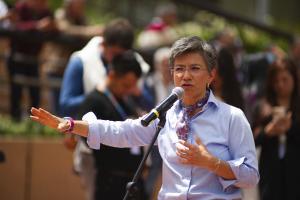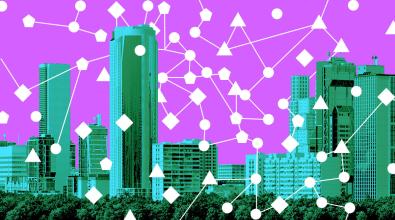Bogotá breaks new ground in city innovation (again). Here's how.
What you need to know about this city's latest pioneering effort.

Bogotá Mayor Claudia López asked her i-team to find ways to bring more residents into the formal banking system. (Sipa via AP Images)
An urban-innovation pioneer for decades, Bogotá is known worldwide for bold experimentation aimed at improving people’s lives. It’s an example-setting approach that has spanned the administrations of several mayors. In the mid-1990s, Mayor Antanas Mockus reduced crime and transformed “citizenship culture” through unconventional tactics like hiring street mimes to mock traffic violators. In 2000, Mayor Enrique Peñalosa ushered in the TransMilenio system that became a global model for rapid bus service. Then in 2016, Mayor Peñalosa and his team reimagined the concept of the “walking school bus” with a Bloomberg Philanthropies Mayors Challenge-winning initiative to make kids’ commutes to school safer and more educational. Last year, the city won the Mayors Challenge again with Mayor Claudia López’s groundbreaking CARE System, which is relieving women from the burdens of unpaid caregiving.
Now, Bogotá is tackling another big challenge: bringing more residents into the formal banking system. City leaders are piloting a new program that helps shop owners and street vendors safely access the credit they need to grow their businesses and build wealth.
The city’s ambitious approach brings data and digital tools to bear in exciting ways that city leaders around the world can learn from. With that in mind, here’s a closer look at how Mayor López’s team used innovation to address challenges in the lending market:
- Tackling a tough challenge
- Building a breakthrough solution
- Strong innovation muscles
- Putting innovation to work
- What other cities can learn
Tackling a tough challenge
Borrowing from banks and other formal financial operators is not an option for many of Bogotá’s 8 million residents. Banks are hesitant to lend to small merchants because they often lack credit scores and it is difficult to assess the risk of lending to them. In addition, banks generally are not present—and are widely distrusted—in low-income neighborhoods. According to the World Bank, only 19 percent of Colombians had borrowed money from a formal financial institution or were using a mobile money account in 2021.
This means that when shop owners or street vendors in Bogotá’s vast informal economy need a loan to buy inventory or grow their business, they often turn to loan sharks who offer what are known as gota a gota loans, which are illegal and come with interest rates that can run as high as 30 percent per day. People who fall behind on payments often become targets of violence.
These problems are not unique to Bogotá. About 1.4 billion people around the world lack access to formal banking and financial services, limiting their options to save or borrow money, invest in homes or businesses, and build wealth. While the gaps are largest in developing economies, nearly 6 million U.S. households are among the “unbanked.”
Building a breakthrough solution
Bogotá city leaders are opening the formal lending system to more residents, starting with small businesses. The hope is to enable entrepreneurs to get the loans they need to build their businesses and earn more income, which aligns with Mayor López’s ambitious efforts to reduce poverty and improve quality of life for residents. The pilot program, known as Creditó Peso a Peso, is built around two innovations.
The first is an alternative credit score, based on city-owned data, that banks can use to measure credit risk. While nonprofits, foundations, commercial banks, and others have been working on alternative ways of establishing credit risk—some using smartphone app data, call logs, or social media analysis, for example—it is unusual for city leaders to be the ones leading the charge.
The second is a digital interface where borrowers can apply for loans. That process soon will be available through WhatsApp, the messaging service that nearly all Colombians have and use on their phones. The idea is to make it as easy as possible for borrowers to access lending that is safe and fair—everything gota a gota loans are not.
The average loan amount is anticipated to be about $400—a significant investment for the average street food vendor or mechanic. So far, the program has facilitated 177 successful loans totaling over $75,000—with a goal of facilitating 10,000 loans by the end of the year.
Soon, the approach may scale up even bigger. A new national government in Colombia is looking to launch its own financial inclusion program, with an aim of making 1 million loans. Conversations are underway about using the methodology behind the Bogotá i-team’s alternative credit score as part of that broader effort.
Strong innovation muscles
Creditó Peso a Peso calls on every aspect of City Hall’s growing innovation expertise. A key player is Bogotá’s digital innovation team, an in-house consultancy supported by Bloomberg Philanthropies to accelerate the city’s digital transformation. In addition to designing and testing pilots like this lending program, the i-team is focused on building a community of practice for innovators across city government to learn about each other’s work and find new ways to collaborate.
The i-team is led by Santiago Amador, who has built a Swiss Army knife of a team possessing skill sets ranging from data science to technology to user experience to graphic design. There’s also a group known as the design task force, which Amador taps for surge capacity to tackle discrete problems that call for particular expertise. “At the end of the day, innovation is about a team,” Amador says, “and having different capabilities you can put toward solving any specific problem.”
Collaboration across agencies and sectors is critical to tackling systemic challenges like illegal lending. That’s why Bogotá’s i-team is itself set up as a collaboration among three groups: the city’s innovation lab, known as iBO; the data analytics agency Ágata; and the High Council on Information and Communications Technolgy. The three agencies have a governance committee to ensure that they are working closely together. The lending project also involves collaboration with the city’s economic development agency and two private banks, among others.
Increasingly, the public actors in Bogotá’s innovation ecosystem are focused on finding opportunities to partner with the private sector to solve tough problems. Illegal lending is a good example of that. Ágata’s expertise in data analytics was especially critical to building the algorithm that powers the alternative credit score.
Putting innovation to work
Because illegal lending is a complex system that is deeply ingrained in Bogotá’s large informal economy, the city needed to deploy one of the most important innovation tools in its arsenal—human-centered design—to fully understand the challenge at hand. For this project, that meant deploying 200 young people into neighborhoods to interview residents about why, despite the well-known risks, they obtain these illegal loans. The team also sought to understand the existing system from the perspective of the illegal lenders who are currently serving this market, as well as the formal banks who aren’t.
This research led to several insights that drove the direction of the team’s work. One was that banks think it’s too risky to lend to small merchants because of the lack of credit scores. Another was that the illegal lenders make it incredibly easy to get a loan. “The user experience that gota a gota provides is way better than going to a bank,” says Angela Reyes, the i-team’s digital transformation lead. “They offer you money on the spot. You don’t have to go to a bank and fill out lots of difficult forms.”
The i-team then worked with both borrowers and banks to co-create, develop, and test potential solutions. For the first breakthrough, credit scores, the i-team worked closely with Ágata to identify publicly owned datasets that could be used to help convey a resident’s credit risk. Those include billing and payment data from the city’s water and telecom utilities, as well as databases on small businesses, social services, and more.
Ágata then built an algorithm using this data that can function as an alternative credit score. Two local banks are experimenting with taking that public data and putting it together with their own data sources to decide whether or not to offer loans. As the pilot testing continues, the algorithm will continue to be updated, and more banks will be invited to participate in the program.
The second breakthrough is aimed at making the experience of applying for a bank loan as simple—or even easier—than getting a gota a gota loan. That started with a page on the city’s website where borrowers can apply for loans by providing a minimal amount of personal information. It will next be reflected in the WhatsApp integration, which will utilize a chatbot the city has created, known as Chatico.
Development of these interfaces is drawing on several tenets of innovation. First, the technology is poised to enable the solution to scale up, by design. Second, the i-team is testing the website and chatbot extensively with users to make sure that they’re intuitive and simple to use. And finally, they build on exactly what borrowers said they were looking for: an easy user experience. “We want to make it as easy as possible to apply,” Amador says. “It’s in your cell phone. You have a need—and it’s right there. It has to be that available.”
Sonja Kelly, a global financial inclusion expert with the NGO Women’s World Banking, says the push to make the loans available through WhatsApp is a significant advancement for the field. “Financial services innovations have to meet people where they are,” she says. “Whatever the most convenient solution that seems reasonable is the one they’re going to gravitate towards.”
What other cities can learn
While Bogotá’s solution is aimed at financial inclusion, cities can learn from it to apply similar approaches to address climate change, housing shortages, and other critical problems that cut across sectors.
A key lesson is that cities possess data that private-sector partners and others can use to unlock value for residents and help solve public problems. Bogotá is “taking data that the city already has and shows what people already are doing and puts that together in a way that benefits communities,” explains Afua Bruce, founder of ANB Advisory Group and author of the recent book, “The Tech That Comes Next: How Changemakers, Philanthropists, and Technologists Can Build an Equitable World.” “The more that government institutions can think of what data we have—and how we can use it in a new way to address problems that our communities are facing—the better.”
A related lesson is that just as municipalities build roads and hard infrastructure for all to use, there’s a role cities can play in building the digital infrastructure that enables private actors to serve residents better. Sonja Kelly, a global financial inclusion expert with the NGO Women’s World Banking, says Bogotá is advancing the field in an area that is ripe for government innovation: digital public infrastructure. “Bogotá is bridging that space between the industry’s need for more data and the customers’ need for loans,” she says. “There has been very little innovation from credit bureaus. So there is a huge gap that this initiative is filling.”
Finally, Bogotá is demonstrating the power of listening to residents and meeting them where they are. Amador stresses the importance of not jumping to solutions but listening first to the experiences and needs of residents and other stakeholders, and building a strategy with them. “Everyone wants to rush when implementing public policy, but we say, no—we are going to follow the recipe of innovation,” Amador explains. “Normally, the public process is not informed by residents and their needs. We held space to do a very rigorous research process to actually understand the problem and work with the people to build solutions.”



